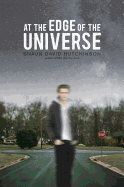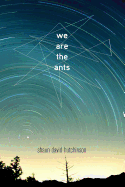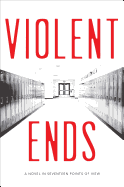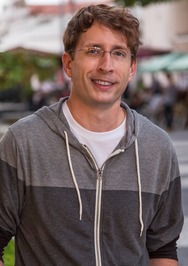TeachingBooks.net is delighted to welcome author Shaun David Hutchinson as our featured guest blogger this month.
Each month, we ask distinguished authors or illustrators to write an original post that reveals insights about their process and craft. Enjoy!
Real Queer Characters
by Shaun David Hutchinson
 Recently, I participated on a panel at the North Texas Teen Book Festival titled, “Reading the Rainbow.” It was a 90-minute session during which the audience was given an opportunity to ask six queer authors anything. Because of the panel’s popularity in previous years, it was twice the length of other sessions, and the room was packed. Every question was amazing, and my 16-year-old self would have done anything to have sat in on a discussion like that. Much to my surprise, the question I heard most often, phrased in different ways, was: How do I write queer characters that are three-dimensional?
Recently, I participated on a panel at the North Texas Teen Book Festival titled, “Reading the Rainbow.” It was a 90-minute session during which the audience was given an opportunity to ask six queer authors anything. Because of the panel’s popularity in previous years, it was twice the length of other sessions, and the room was packed. Every question was amazing, and my 16-year-old self would have done anything to have sat in on a discussion like that. Much to my surprise, the question I heard most often, phrased in different ways, was: How do I write queer characters that are three-dimensional?
 On the surface, it seems like a question we’ve all heard before, right? Every person who’s tried to write has, at one point or another, struggled to create flesh-and-blood characters. And every reader has read characters that leap off the page and others who come across as flimsy and uninspired. Usually, the failure to write a great three-dimensional character stems from a lack of understanding. The author is trying to write about someone unfamiliar to them, and he or she hasn’t done enough research. But the questions during the rainbow panel were different because of who was asking them. We were in a room filled with teens and adults who were either queer or who had queer friends and family members, and they were asking how to see people like themselves and their peers or family as real.
On the surface, it seems like a question we’ve all heard before, right? Every person who’s tried to write has, at one point or another, struggled to create flesh-and-blood characters. And every reader has read characters that leap off the page and others who come across as flimsy and uninspired. Usually, the failure to write a great three-dimensional character stems from a lack of understanding. The author is trying to write about someone unfamiliar to them, and he or she hasn’t done enough research. But the questions during the rainbow panel were different because of who was asking them. We were in a room filled with teens and adults who were either queer or who had queer friends and family members, and they were asking how to see people like themselves and their peers or family as real.
 Most of our answers were some version of: treat them like real people because they are real people. At first, it baffled me that it was still so difficult for this audience to imagine queer characters as people. Maybe I could have understood that 25 years ago when I was a teen, but this was a queer panel filled with queer authors who had all written many books with queer characters. There was no shame in that room, none of the hushed-voice fear we might have felt in decades past. We were there, queer, and we would not disappear.
Most of our answers were some version of: treat them like real people because they are real people. At first, it baffled me that it was still so difficult for this audience to imagine queer characters as people. Maybe I could have understood that 25 years ago when I was a teen, but this was a queer panel filled with queer authors who had all written many books with queer characters. There was no shame in that room, none of the hushed-voice fear we might have felt in decades past. We were there, queer, and we would not disappear.
 There are more books than ever featuring queer characters, but so many of them still treat their queer characters’ sexuality or gender identity as that person’s main attribute. If they’re gay, their story is defined by that—defined by their struggle with their sexual identity or their acceptance of it or other characters’ struggle and acceptance of it. As a culture, we haven’t yet reached the point where queer characters get to be the heroes in stories that have nothing to do with their queer identity—to be the villain or the snarky side character or the henchperson or the parent. There are some books like that—they’re the kinds of books I try to write—but not nearly enough.
There are more books than ever featuring queer characters, but so many of them still treat their queer characters’ sexuality or gender identity as that person’s main attribute. If they’re gay, their story is defined by that—defined by their struggle with their sexual identity or their acceptance of it or other characters’ struggle and acceptance of it. As a culture, we haven’t yet reached the point where queer characters get to be the heroes in stories that have nothing to do with their queer identity—to be the villain or the snarky side character or the henchperson or the parent. There are some books like that—they’re the kinds of books I try to write—but not nearly enough.
 This is why representation matters. We can’t pat ourselves on the backs yet. Not until there are as many stories by, for, and about queer teens as there are of non-queer teens. Not until these writers are confident creating queer teens who are funny and talented and vicious and flawed and so real that they crawl off the page. Not until these writers stop asking, “How can I make my queer characters real?” and begin asking, “How can I make my characters real?”
This is why representation matters. We can’t pat ourselves on the backs yet. Not until there are as many stories by, for, and about queer teens as there are of non-queer teens. Not until these writers are confident creating queer teens who are funny and talented and vicious and flawed and so real that they crawl off the page. Not until these writers stop asking, “How can I make my queer characters real?” and begin asking, “How can I make my characters real?”
 Hear Shaun David Hutchinson talk about how he came to write At the Edge of the Universe!
Hear Shaun David Hutchinson talk about how he came to write At the Edge of the Universe!
Listen to Shaun David Hutchinson discuss his book We Are the Ants!
Hear Shaun David Hutchinson talk about the story behind Violent Ends!
Learn how to pronounce Shaun David Hutchinson’s name!


Leave a Reply